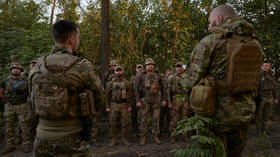ISIS propaganda crippled by military defeats, study finds

Islamic State’s online media output has dropped drastically as advertising a viable caliphate becomes harder amid military defeats, US scholars found. Another reason for it is that many propagandists were killed in airstrikes, becoming “media martyrs.”
Once notorious for inspiring thousands of foreign fighters to wage jihad in Syria and Iraq, Islamic State’s (IS, formerly ISIS/ISIL) online propaganda coverage is now shrinking, according to a study released by Combating Terrorism Center at the US Military Academy West Point.
Hearts & minds: #Google-run project to tackle #ISIS propaganda, target US far right https://t.co/RMD2fXNAxapic.twitter.com/FH7AdBAX8a
— RT (@RT_com) September 8, 2016
Last August, the terrorist group produced over 700 media items in its “official” outlets in Syria and other countries, the research says. In August this year, there were only 200.
“It’s not just the numeric decline,” Daniel Milton, who authored the report, told the New York Times. “The caliphate was their big selling point. Now there’s an inability to say we’re doing the things that make us a state. And that was behind their broad appeal.”
Since 2014, IS’s online propaganda was efficient not just because it featured sophisticated and high-quality videos, graphics and social media posts, but because its message tended to reach Muslims all over the world, urging them to come to a viable Sharia state with functional institutions, bureaucracy and welfare system.
Pentagon paid PR firm $540mn to make fake terrorist videos https://t.co/DVMHdnICcjpic.twitter.com/xcKMfnClE5
— RT (@RT_com) October 4, 2016
Throughout 2015, thousands of foreign fighters came to either Syria or Iraq on the back of the terrorist group’s military advance on the ground. Now, though IS still holds sizeable parts of both countries, things are different, Milton’s study notes.
Decimated in air campaigns run by Russia and the US-led coalition, IS looks less like a messianic state and more like a weakening terrorist army, the research claims.
“The Islamic State’s media people are fighters, too. And when they’re fighting, they can’t put out their message,” adding that some media personnel killed in airstrikes have been eulogized as “media martyrs.”
Interestingly, IS has reduced the production of its most gruesome media items, namely broadcast beheadings of hostages, making instead more videos showing executions of its own militants for espionage and treason.
Over the past months, many social media platforms, including Twitter, have aggressively suppressed IS-related posts and accounts. Google has launched an online project tackling terrorist propaganda by redirecting users to anti-Islamism links.
However, there are still some indications that battling IS’s online presence is far from over. Milton cites one alarming yet unpredictable trend – the group expands domestic propaganda to indoctrinate people living in territories it controls.
“How do you deal with all the children who have had these experiences and who have been exposed to this worldview?” Milton said. “This is going to be a long-term problem.”














